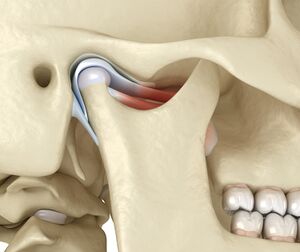Aetiology, Symptoms and Clinical Classifications of Temporomandibular Disorders: Difference between revisions
No edit summary |
No edit summary |
||
| Line 4: | Line 4: | ||
<div class="noeditbox">This article or area is currently under construction and may only be partially complete. Please come back soon to see the finished work! ({{REVISIONDAY}}/{{REVISIONMONTH}}/{{REVISIONYEAR}})</div> | <div class="noeditbox">This article or area is currently under construction and may only be partially complete. Please come back soon to see the finished work! ({{REVISIONDAY}}/{{REVISIONMONTH}}/{{REVISIONYEAR}})</div> | ||
Introduction | == Introduction == | ||
[[File:Jaw closed.jpg|thumb|Figure 1. Temporomandibular joint.]] | |||
The temporomandibular joint (TMJ) is considered one of the most complex joints in the body. It plays a significant role in dental occlusion and the neuromuscular system.<ref name=":0">Chang CL, Wang DH, Yang MC, Hsu WE, Hsu ML. [https://onlinelibrary.wiley.com/doi/full/10.1016/j.kjms.2018.01.004 Functional disorders of the temporomandibular joints: Internal derangement of the temporomandibular joint]. Kaohsiung J Med Sci. 2018;34(4):223-30. </ref> | |||
It has been classified as both a compound joint and a double joint. Compound joints typically consist of three or more bones, but the TMJ only has two bones. Instead of a third bone, an articular disc sits between the mandibular fossa and the condyle (Figure 1).<ref name=":0" /> | |||
The anatomy, biomechanics and physiology of the TMJ are discussed in detail [[Anatomy of the Temperomandibular Joint|here]] and [[Physiology and Biomechanics of the Temporomandibular Joint|here]]. | |||
[[Category:Course Pages]] | [[Category:Course Pages]] | ||
[[Category:Physioplus Content]] | [[Category:Physioplus Content]] | ||
[[Category:Musculoskeletal/Orthopaedics]] | [[Category:Musculoskeletal/Orthopaedics]] | ||
Revision as of 12:20, 18 October 2021
Top Contributors - Jess Bell, Wanda van Niekerk, Kim Jackson and Olajumoke Ogunleye
Introduction[edit | edit source]
The temporomandibular joint (TMJ) is considered one of the most complex joints in the body. It plays a significant role in dental occlusion and the neuromuscular system.[1]
It has been classified as both a compound joint and a double joint. Compound joints typically consist of three or more bones, but the TMJ only has two bones. Instead of a third bone, an articular disc sits between the mandibular fossa and the condyle (Figure 1).[1]
The anatomy, biomechanics and physiology of the TMJ are discussed in detail here and here.
- ↑ 1.0 1.1 Chang CL, Wang DH, Yang MC, Hsu WE, Hsu ML. Functional disorders of the temporomandibular joints: Internal derangement of the temporomandibular joint. Kaohsiung J Med Sci. 2018;34(4):223-30.







